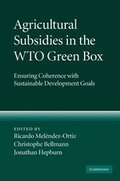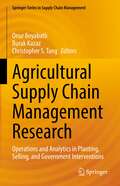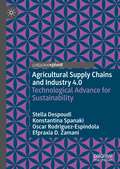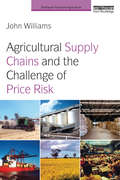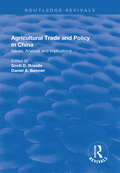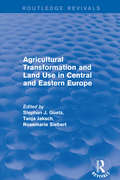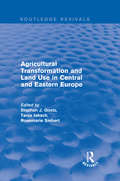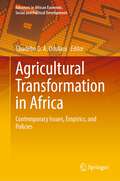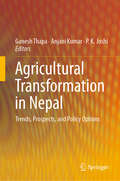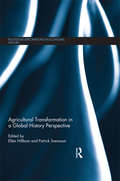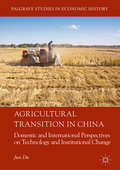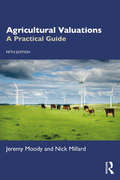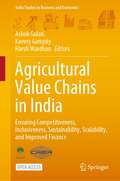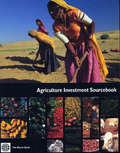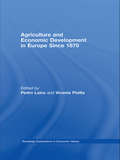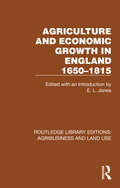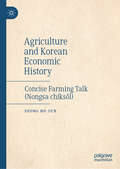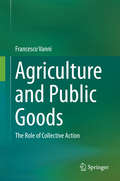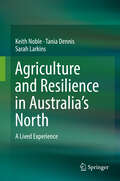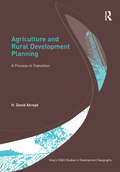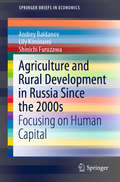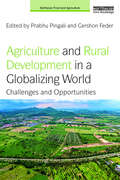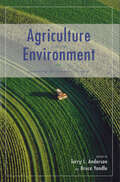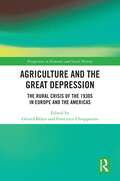- Table View
- List View
Agricultural Subsidies in the WTO Green Box: Ensuring Coherence with Sustainable Development Goals
by Ricardo Meléndez-Ortiz Christophe Bellmann Jonathan HepburnDo the World Trade Organization's rules on 'green box' farm subsidies allow both rich and poor countries to achieve important goals such as food security, or do they worsen poverty, distort trade and harm the environment? Current WTO requirements set no ceiling on the amount of green box subsidies that governments can provide, on the basis that these payments cause only minimal trade distortion. Governments are thus increasingly shifting their subsidy spending into this category, as they come under pressure to reduce subsidies that are more directly linked to production. However, growing evidence nonetheless suggests that green box payments can affect production and trade, harm farmers in developing countries and cause environmental damage. By bringing together new research and critical thinking, this book examines the relationship between green box subsidies and the achievement of sustainable development goals, and explores options for future reform.
Agricultural Supply Chain Management Research: Operations and Analytics in Planting, Selling, and Government Interventions (Springer Series in Supply Chain Management #12)
by Christopher S. Tang Onur Boyabatlı Burak KazazThis book focuses on three essential elements of agricultural supply chains: Planting and Growing, Processing and Selling, and Government Interventions. For decades, most agricultural economists applied macro-economic theory in decisions pertaining to the optimization of food production and distribution. However, few researchers used micro-economic theory to examine how individual farmers respond to market information, incentive pricing mechanisms and different market structures in the trade of agricultural goods. Examining challenges in agricultural supply chain operations through the lens of micro-economic theory is imperative because it can enable policymakers and social enterprises to develop and design market information provision policy, incentive contracts and market structures for improving farmer and consumer welfare.In each chapter, contributing authors motivate their research questions by providing the context and articulating the importance of their questions. They present their analysis to examine the respective research questions and explain their results. At the end of each chapter, they provide a short list of future research questions.
Agricultural Supply Chains and Industry 4.0: Technological Advance for Sustainability
by Stella Despoudi Konstantina Spanaki Oscar Rodriguez-Espindola Efpraxia D. ZamaniThis book explores the impact of industry 4.0 on agricultural supply chains, exploring how changes such as increased digitisation, automation, and the digital value chain, will impact food production globally.At a time when increasing population and environmental degradation puts stress on food supply chains, traditional farming operation models struggle to maintain both sustainability and transparency. Industry 4.0 could lead to digitalised ways of farming and agricultural production processes that will transform the traditional operating and process models to digital, data-intensive methods focusing on analytics and decision-making practices.This book aims to provider the reader with an understanding of the concept of Agriculture 4.0 in relation to supply chain management. Different applications of Agricultural 4.0 supply chains are discussed in relation to their respective advantages and disadvantages.Dr. Stella Despoudi is Lecturer in Operations and Supply Chan Management at Aston University and Adjunct Lecturer in Supply Chain Management at the University of Western Macedonia, Greece.Dr. Konstantina Spanaki is a Lecturer in Information Management at Loughborough University, UK.Dr. Oscar Rodríguez-Espíndola is a Senior lecturer in Operations and Supply Chain Management at Aston University and a member of the Aston CRISIS centre, UK.Dr. Efpraxia Zamani is a Senior Lecturer of Information Systems at the University of Sheffield, UK.
Agricultural Supply Chains and the Challenge of Price Risk (Earthscan Food and Agriculture)
by John WilliamsThis book discusses the issues of integration within food and fibre supply chains and the challenges in managing price risk. The problems of integration and price risk are interwoven in agricultural supply chains with production and supply risk as well as hoarding. However, without supply chain integration through commercial trade markets there can be no forward market upon which forward transactions and the management of price risk can be based. Without a forward market that can reduce opportunistic behaviour, there is likely to be little security of supply, particularly under high production risk and price uncertainty. Whilst price risk management is possible under certain circumstances, there are many factors that can prevent the development of forward markets or cause them to collapse, thus undermining the ability to manage price risk within acceptable risk and return parameters. Market positions therefore need to be valued and often settled daily due to the risk of contract default. In addition, the issue of currency risk and its management applies to international market positions and transactional exposures. The book analyses a range of price risk management strategies from forward contracting through to futures and options hedging, and finally to over-the-counter products. Evaluation techniques are developed to aid decision-making. The author concludes that forward market development may be the exception rather than the norm, and that whilst favourable price risk management outcomes may be possible, they can sometimes be caused more by luck than through good management. It is shown how tactics are an important consideration in decision-making to minimize costs and losses.
Agricultural Trade and Policy in China: Issues, Analysis and Implications (The Chinese Trade and Industry Series)
by Ian Long Scott D. RozelleThis title was first published in 2003. This prominent and commanding volume collates the best research available on China's agricultural trade. Critically analyzing the agricultural supply and demand factors that underlie trade patterns such as agricultural productivity and policy, it also explores China's agricultural trade and policy including implications for China and elsewhere. Long term issues and productivity growth are taken into consideration, as are specific issues such as WTO accession. The slate of authors combines the leading established scholars in the field and the best of the next generation, including those from China and the West.
Agricultural Transformation and Land Use in Central and Eastern Europe
by Stephan J. Goetz Tanja JakschThis title was first published in 2001. By presenting research from a multi disciplinary perspective, this book will serve as an important reference tool for researchers and others interested in the land use issues of Central and Eastern Europe as well as agribusiness leaders seeking potential trading relations with and within these European countries.
Agricultural Transformation and Land Use in Central and Eastern Europe
by Stephan J. Goetz Tanja JakschThis title was first published in 2001. By presenting research from a multi disciplinary perspective, this book will serve as an important reference tool for researchers and others interested in the land use issues of Central and Eastern Europe as well as agribusiness leaders seeking potential trading relations with and within these European countries.
Agricultural Transformation in Africa: Contemporary Issues, Empirics, and Policies (Advances in African Economic, Social and Political Development)
by Gbadebo O. A. OdularuThis book offers new insights into the ongoing agricultural transformation in Africa. Presenting case studies, macro-level simulations, and relevant surveys, it analyzes food crops and agri-food policy challenges and their implications in various African countries. In addition, it discusses how current African agri-food policies could be improved to achieve the continental vision of sustainable development in light of the African Union’s Agenda 2063. The respective contributions address topics such as drivers of technical efficiency among smallholder maize farmers; farm management practices; agri-food infrastructure policies; food security; agricultural growth; and financing for and investment in agricultural production. Accordingly, the book appeals to scholars of economics and agricultural studies and to anyone interested in the agricultural transformation of Africa.
Agricultural Transformation in Nepal: Trends, Prospects, and Policy Options
by P. K. Joshi Ganesh Thapa Anjani KumarThis book addresses some key strategic questions related to agriculture in the context of major contemporary developments and emerging challenges in Nepal such as the changing role of agriculture with economic growth, structural transformation in reducing poverty, improving nutritional outcomes, and addressing the challenges of climate change. The book also suggests policy measures to improve the delivery of critical inputs and services and ensure the participation of marginal and smallholders in high-value chains. Further, it discusses how the new federal system and governance structure will affect the delivery of agricultural technology and services. The book is divided into five parts. Part I discusses macro-issues in the agriculture sector, while Part II focuses on agricultural productivity growth and its main drivers. The third part explores diversification in the agricultural and non-agricultural sectors by farmers and other rural people for livelihood improvement, while the fourth part deals with agricultural trade and marketing issues, highlighting policy implications and recommendations in the areas of immediate focus and further research. Lastly, Part V addresses institutions and governance issues, which are vital for agricultural development. In the final chapter, the editors summarize and synthesize the book’s main findings and develop a policy agenda for addressing the many challenges faced by the agriculture sector in Nepal, so as to make it more productive, competitive, sustainable, and inclusive. The book offers a rich source of analytical information on various aspects of agricultural development in Nepal and will be of immense value to policymakers, development partners, civil society, students, and those interested in the economic and agricultural development of not only Nepal, but also other developing countries.
Agricultural Transformation in a Global History Perspective (Routledge Explorations in Economic History)
by Ellen Hillbom Patrick SvenssonHistory teaches us that agricultural growth and development is necessary for achieving overall better living conditions in all societies. Although this process may seem homogenous when looked at from the outside, it is full of diversity within. This book captures this diversity by presenting eleven independent case studies ranging over time and space. By comparing outcomes, attempts are made to draw general conclusion and lessons about the agricultural transformation process.
Agricultural Transition in China: Domestic And International Perspectives On Technology And Institutional Change (Palgrave Studies In Economic History)
by Jun DuDeepens readers’ understanding of the nature of contemporary Chinese economic development .<P><P> Relaxes the hypothesis of the perfect market condition to discuss institutional and technological changes in Chinese post-reform agriculture under the complex market institution.<P> Highlights the decisive role of market institutions in determining the selection and transition of agricultural technologies.<P> This book extends current research on the political economy of modern China, with particular regard to agricultural development and its role in economic transition. It uses Neoclassical principles to re-interpret agricultural growth and technological change under complex market institutions with empirical studies on China and selected East Asian economies. The text also questions how technological advances in China contribute to the Great Divergence debate.<P> Through a comparative analysis of agricultural technical changes in the planting of rice paddies in Japan, Taiwan and China, Du finds that different market institutions and structures have given rise to considerable diversity of agricultural change between different economies in terms of the nature, timing and duration of technological transition. Such diversification has, in turn, affected the trajectories of agricultural and wider economic growth.<P> Here, Du reflects on the nature of contemporary Chinese economic development and extends observations on agricultural transition to the entirety of Asia, finding that the nature, timing, and time-span of agriculture technology transitions have varied considerably across different economies. <P>
Agricultural Valuations: A Practical Guide
by Jeremy Moody Nick MillardAgricultural Valuations: A Practical Guide has long been the standard text for students and professionals working on agricultural valuations. Taking a practical approach, it covers all the relevant techniques and legislation necessary to correctly value farms, assess farm rents, carry out arbitrations, inventories and records of condition, including valuation clauses on sales of farms, livestock, soils, management agreements, valuation in court proceedings and a glossary of useful information. In this fifth edition, Gwyn Williams's original text is taken on by Jeremy Moody and Nick Millard, renowned experts in the field, bringing the book right up to date to reflect recent changes in the rural economy, including development, diversification and renewable energy and specialist valuations and reference to all the latest legislation. Clear and accessible to students and professionals alike, readers will find Agricultural Valuations an invaluable guide to best practice in agricultural valuations.
Agricultural Value Chains in India: Ensuring Competitiveness, Inclusiveness, Sustainability, Scalability, and Improved Finance (India Studies in Business and Economics)
by Harsh Wardhan Ashok Gulati Kavery GangulyThis open access book provides a clear holistic conceptual framework of CISS-F (competitiveness, inclusiveness, sustainability, scalability and access to finance) to analyse the efficiency of value chains of high value agricultural commodities in India. It is based on the understanding that agriculture is an integrated system that connects farming with logistics, processing and marketing. Farmer’s welfare being central to any agricultural policy makes it very pertinent to study how a value chain works and can be strengthened further to realize this policy goal. This book adds value to the existing research by studying the value chains end-to-end across a wide spectrum of agricultural commodities with the holistic lens of CISS-F. It is not enough that a value chain is competitive but not inclusive or it is competitive and inclusive but not sustainable. The issue of scalability is very critical to achieve macro gains in terms of greater farmer outreach and sectoral growth. The research undertaken here brings out some very useful insights for policymaking in terms of what needs to be done better to steer the agricultural value chains towards being more competitive, inclusive, sustainable and scalable. The value chain specific research findings help draw very nuanced policy recommendations as well as present a big picture of the future direction of policy making in agriculture.
Agriculture Investment Sourcebook
by World BankInvesting to promote agricultural growth and poverty reduction is a central pillar of the World Bank's current rural strategy, 'Reaching the Rural Poor' (2003). This 'Sourcebook' addresses how to implement the rural strategy, by sharing information on investment options and identifying innovative approaches that will aid the design of future lending programs for agriculture. It provides generic good practices and many examples that demonstrate investment in agriculture can provide rewarding and sustainable returns to development efforts. It is divided into eleven self-contained modules. Each module contains three different types of subunits that can also be stand-alone documents: I. Module Overview II. Agricultural Investment Notes III. Innovative Activity Profiles. The stand-alone nature of the subunits allows flexibility and adaptability of the material. Selected readings and web links are also provided for readers who seek more in-depth information. The 'Sourcebook' draws on a wide range of experiences from donor agencies, governments, institutions, and other groups active in agricultural development. It is an invaluable reference tool for policy makers, professionals, academics and students, and anyone with an interest in agricultural investments.
Agriculture and Economic Development in Europe Since 1870 (Routledge Explorations in Economic History)
by Pedro Lains Vicente PinillaWhilst many books on the European economy have focused on the analysis of its industrial sectors, this book draws attention to the often ignored contribution made by the development of European agriculture over the past two centuries. In doing so, the authors adopt a revisionist perspective on the subject, addressing the lack of coherent study of the agricultural sector and reassessing old theories about the links between agricultural and economic development. In focusing on those countries which by 1870 still had a large agricultural sector, namely, France, Germany, Italy, Denmark, The Netherlands, Sweden, Spain, Portugal, Poland, Hungary, Greece and Turkey, this book determines the role of the agricultural sector in the economic development of Europe. These chapters demonstrate how the rate of development in the agricultural sector depended on specific industrial, political and market conditions; the diversity of ways and timings through which transformation was achieved is also considered.
Agriculture and Economic Growth in England 1650-1815 (Routledge Library Editions: Agribusiness and Land Use #15)
by E. L. JonesOriginally published in 1967, this was the first book to discuss why agricultural supply became more ‘responsive’ and to provide broadly based evidence of the ways in which that ‘responsiveness’ may have influenced the growth of the economy. The editor chose 7 essays, reprinted in full, to illustrate altered perspectives of agricultural change. His substantial introduction places the beginnings of a significant rise in farm output as far back as the mid-seventeenth century and concludes that agriculture played a vital but complicated role in the economy of eighteenth-century England.
Agriculture and Industry in Brazil: Innovation and Competitiveness
by Albert Fishlow José Eustáquio Vieira FilhoAgriculture and Industry in Brazil is a study of the economics of Brazilian agriculture and industry, with a special focus on the importance of innovation to productivity growth. Albert Fishlow and José Eustáquio Ribeiro Vieira Filho examine technological change in Brazil, highlighting the role of public policy in building institutions and creating an innovation-oriented environment.Fishlow and Vieira Filho tackle the theme of innovation from various angles. They contrast the relationship between state involvement and the private sector in key parts of the Brazilian economy and compare agricultural expansion with growth in the oil and aviation sectors. Fishlow and Vieira Filho argue that modern agriculture is a knowledge-intensive industry and its success in Brazil stems from public institution building. They demonstrate how research has played a key role in productivity growth, showing how prudent innovation policies can leverage knowledge not only within a particular company but also across whole sectors of the economy. The book discusses whether and how Brazil can serve as a model for other middle-income countries eager to achieve higher growth and a more egalitarian distribution of income. An important contribution to comparative, international, and development economics, Agriculture and Industry in Brazil shows how the public success in agriculture became a prototype for advance elsewhere.
Agriculture and Korean Economic History: Concise Farming Talk (Nongsa chiksǒl)
by Seong Ho JunThis book is an economic history of the Chosŏn dynasty (1392-1910). The Chosŏn dynasty is not only known for managing the northeastern regions of Asia for 500 years as the exemplars of Confucianism, their kingdom was also one of the greatest so-called “agricultural states under Heaven.” The Chosŏn dynasty has been briefly explored academically by Western scholars, but their findings have some limitations. The period of 1400-1600, in particular, has been too poorly reported on in the English language to gain the attention of the Western knowledge society. This book aims to fill the gaps in the existing research and will be of interest to economists, scholars of Korean history, agriculturists, and ecologists.
Agriculture and Public Goods: The Role of Collective Action
by Francesco VanniThe debate on the future orientation of the EU Common Agricultural Policy (CAP) is increasingly shaped by the role of agriculture in providing public goods, and there is a broad consensus that this approach will be particularly relevant in legitimating the policy intervention in agriculture in the future. In the context of this debate, it is not clear to what extent collective action could be taken into consideration as a valuable alternative to market or state regulation in contributing to the provision of public goods, and to what extent it is possible to design and implement agricultural policies that incorporate a collective and collaborative approach between different stakeholders in rural areas. Through an in depth analysis two case studies in Italy, the book provides insights to both the policy and the theoretical debate on the role of collective action for the public goods associated to agriculture.
Agriculture and Resilience in Australia’s North: A Lived Experience
by Keith Noble Tania Dennis Sarah LarkinsThis book examines the mechanisms and strategies farmers in North Australia adopt to manage the setbacks and challenges they face. This social research is based on farmers’ experiences, but also draws on the author’s own experience after his tropical fruit farm was destroyed by two Category 5 cyclones in five years.Through historical analysis, the book compares historic and contemporary aspirations for northern development, and discusses the influence of the built environment on individuals as well as access to health and other social services.Exploring the implications of individual resilience strategies for policy development within the broader context of northern development and evolving environmental governance, the book also highlights the fact that this is occurring in a new geological epoch – the Anthropocene.The book will provide a unique perspective and understanding to government, individuals and industries interested in northern Australia and its relationship to the world
Agriculture and Rural Development Planning: A Process in Transition (King's SOAS Studies in Development Geography)
by H. David AkroydThis book meets the needs of teachers and students of agriculture and rural development project and programme planning, planners employed by governments in developing countries and by external financing agencies. Project planners must understand the aspirations of rural families and their local leaders, the national development and sector planning goals and policies of their governments and the development goals and policy priorities perceived by external financing agencies in relation to their countries. These areas are not always consistent and trade-offs may be required. However it is recognised that poor project planning is a major constraint to the sustainable realization of project and programme objectives and sector goals. Illustrated with case studies and logical framework matrices, this book presents well-established and relatively new practices followed in the context of agriculture and rural development project and programme planning. Although based on experiences gained in Africa, the issues described are relevant to planning problems encountered in other developing regions of the world. It addresses the main factors which affect the success of planning such as a government's ability to guarantee macro-economic stability and sound sector development policies; the shift from 'top-down', bureaucratic to 'bottom-up', participatory planning approaches and the roles played by external financing agencies. It explains key technical, financial, economic, environmental, socio-cultural, equity, gender and institutional-strengthening issues concerning planning in rural areas and reviews the planning tools and approaches available. The procurement of goods and services, the disbursement of funds and monitoring and evaluation requirements are examined in detail.
Agriculture and Rural Development in Russia Since the 2000s: Focusing on Human Capital (SpringerBriefs in Economics)
by Lily Kiminami Andrey Baldanov Shinichi FuruzawaThis book clarifies the status quo and mechanisms of agricultural and rural development in today’s Russia, especially focusing on human capital and human development. It provides readers insights into agricultural and rural development from the perspectives of agricultural economics, developmental economics, and regional–spatial science. Further, it addresses key research questions such as whether agricultural development in Russia has made significant strides, whether it has improved the nation’s food security and rural development, and whether structural changes in the agricultural sector as well as human capital have had impacts on agricultural development since the 2000s. In terms of analytical methods, structural equation modeling and stochastic frontier analysis are employed to capture the relationship between agriculture and rural development in regional Russia. In closing, policy challenges are identified to promote social innovation for rural development by enhancing the human capital of rural youth, including entrepreneurship. Given its scope, the book is highly recommended for all readers seeking an in-depth and up-to-date overview of agricultural and rural development in contemporary Russia.
Agriculture and Rural Development in a Globalizing World: Challenges and Opportunities (Earthscan Food and Agriculture)
by Prabhu Pingali; Gershon FederRapid structural transformation and urbanization are transforming agriculture and food production in rural areas across the world. This textbook provides a comprehensive review and assessment of the multi-faceted nature of agriculture and rural development, particularly in the developing world, where the greatest challenges occur. It is designed around five thematic parts: Agricultural Intensification and Technical Change; Political Economy of Agricultural Policies; Community and Rural Institutions; Agriculture, Nutrition, and Health; and Future Relevance of International Institutions. Each chapter presents a detailed but accessible review of the literature on the specific topic and discusses the frontiers in research and institutional changes needed as societies adapt to the transformation processes. All authors are eminent scholars with international reputations, who have been actively engaged in the contemporary debates around agricultural development and rural transformation.
Agriculture and the Environment: Searching for Greener Pastures
by Terry L. Anderson Bruce YandleAlthough US agriculture is the envy of the world, there is a growing gap between what is and what could be produced. The gap is due in part to a growing morass of environmental regulations, which limit US food production without necessarily improving environmental quality. In this compilation, leading experts examine a range of questions posed by these constraints and offer ideas for reform.Authors explore whether we are really running out of prime farmland; how best to preserve environmentally sensitive land, and for how long; whether controls on agricultural land use can prevent urban sprawl; whether chemicals that contribute to agricultural productivity are harmful to the environment; the connections between genetically modified crops and human health; how taxes affect land use; what role water markets play in balancing agricultural productivity and wildlife habitat; and the effects of the Endangered Species Act on land use.
Agriculture and the Great Depression: The Rural Crisis of the 1930s in Europe and the Americas (Perspectives in Economic and Social History)
by Gérard Béaur Francesco ChiapparinoWhat role did the agricultural sector play in the economic crash of 1929? Taking evidence from country cases across Europe and the Americas, this edited volume explores short-, medium- and long-term perspectives on the primary sector. The monograph brings together the voices of an international panel of contributors who examine issues such as falling prices, industrial production, unemployment and the stagnation of aggregate demand. Together, they frame the interwar period as a pivotal turning point in the decline of subsistence agriculture and the growth of agricultural subsidies, which remain a key policy tool in many economies today. This illuminating book will be of interest to advanced students and researchers in economic history, agricultural history, globalization, and economic development.
